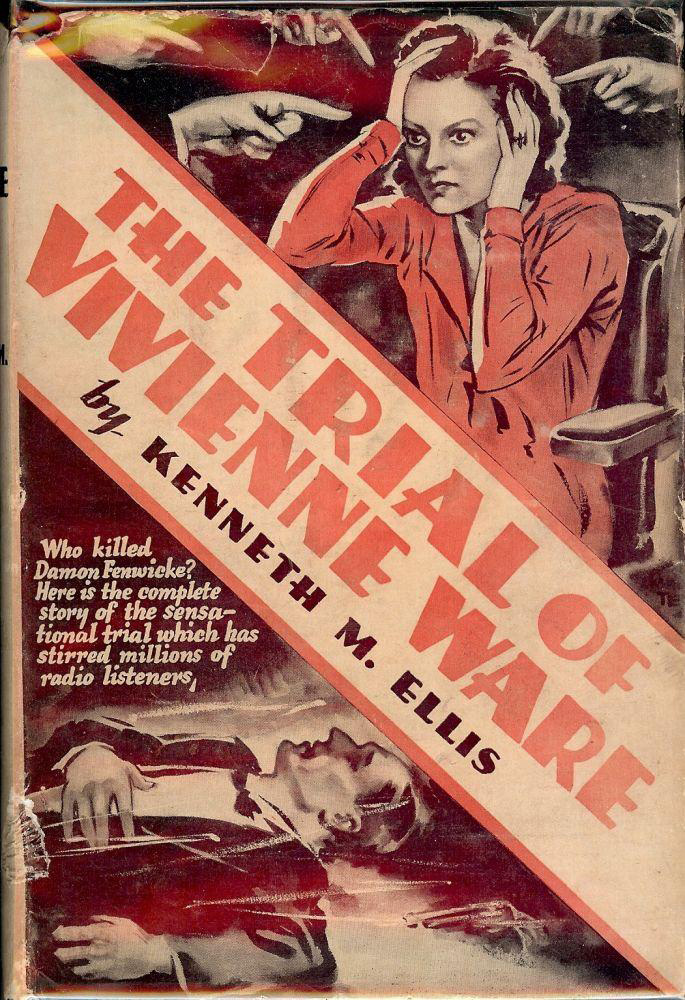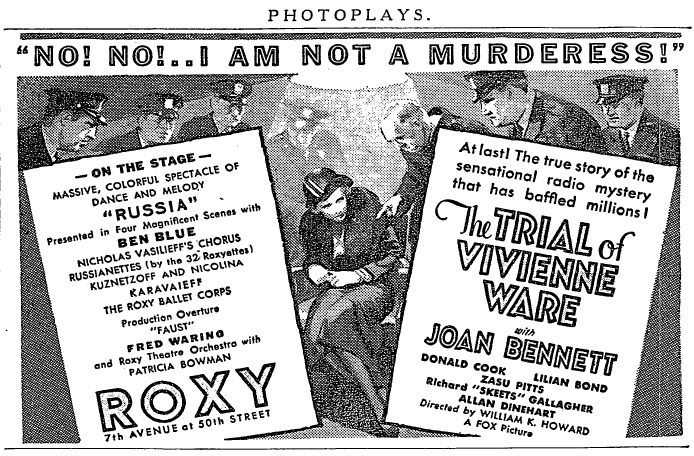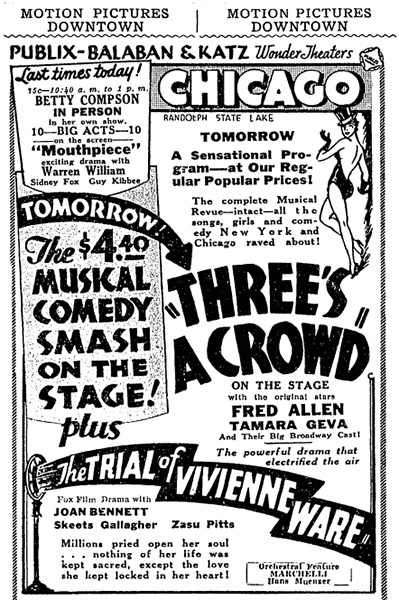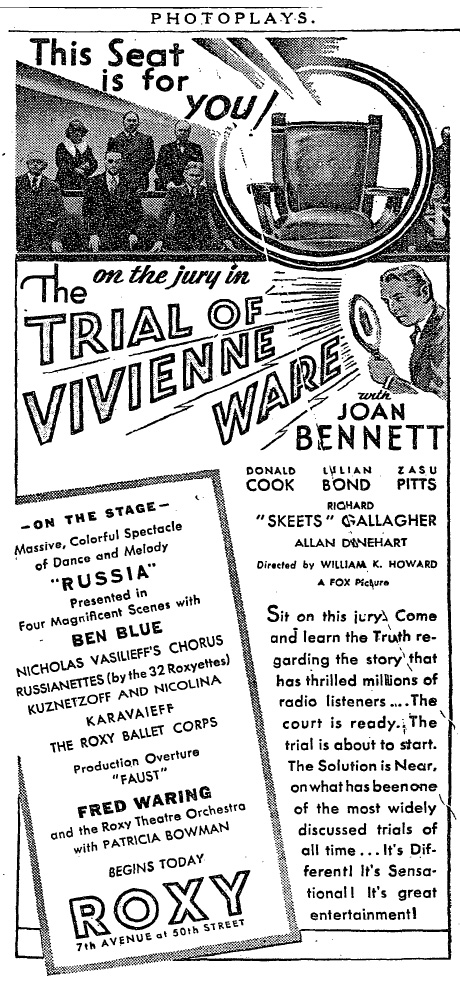It can be difficult to fit into a short screening intro all the fascinating details our Research Associate, Mike Quintero, uncovers about the films we show — so we’ll be sharing some of his raw research notes here on the blog, in no particular order and without much editing, because it seems a shame to keep them to ourselves. Thanks Mike!
This week’s research notes are about: THE TRIAL OF VIVIENNE WARE (William K. Howard, 1932), screened on August 31, 2022 in a 35mm print from the Museum of Modern Art as part of CFS Season 28.
★ Taglines ★
SENSATIONAL / The Most Amazing And BREATH-TAKING INSIDE STORY / Of Men, Women Caught In A Whirlwind Of Passion … Detouring The Wheels Of Justice … Of Desires That Changes The Lives Of Eight People
JOAN BENNETT / You Will Sing Her Praise Anew in This Tense Emotional Radio Drama That Electrified the Air
This Seat is for you! / on the jury in The TRIAL OF VIVIENNE WARE / Sit on this jury. Come and learn the Truth regarding the story that has thrilled millions of radio listeners … The court is ready .. The trial is about to start. The Solution is Near, on what has been one of the most widely discussed trials of all time … It’s Different! It’s Sensational! It’s great entertainment!
Envied by every woman … A match for any man … You peer into the heart and soul of humans who dare. / Thrilling and dazzling you in a maelstrom of drama … It’s sensational and revolutionarily different … truly a “hit” picture of the year.
“NO! NO! .. I AM NOT A MURDERESS!” / At last! The true story of the sensational radio mystery that has baffled millions!
Millions pried open her soul … nothing of her life was kept sacred, except the love she kept locked in her heart!
Millions pried into her soul … millions called her guilty … yet her only guilt was love
The Radio Drama that Electrified the Air
Production Notes:
THE TRIAL OF VIVIENNE WARE originated from a pair of radio dramas that were broadcast from New York’s WJZ, both having to do with the fictional murder of “millionaire architect” Damon Fenwicke.
The first, “The Trial of Vivienne Ware,” was broadcast over six consecutive nights in late November 1930. Presented as a trial of “socially prominent New Yorker” Vivienne Ware for the murder, the story was told “in such a manner as to give the invisible audience a clear picture of the chain of evidence involving Miss Ware.
Furthermore “the radio audience is to be given no verdict in the case, but, will, on the contrary, act as the jury” with prizes to be awarded for those offering the best explanations of their verdicts.
According to an article in the Rome Sentinel, the cast included “prominent members of the New York Bar, a United States Senator and a notable cast of actors from the legitimate stage and broadcasting studios.”
(“Internationally famous lawyer” George Gordon Battle played the counsel for the defense; Ferdinand Pecora, former first assistant district attorney of New York County, portrayed the prosecutor, and sitting U.S. Senator Robert F. Wagner (NY) portrayed the judge.)
The unusual premise and high-profile cast attracted attention to the production, according to the Syracuse Journal:
The unusualness of the broadcast and the presence in it of Wagner, Pecora, and Battle became the talk of the town. Play producers were intensely interested in the enterprise. The dean of the Law School of New York University requested tickets for its performances for his students, that they might observe at first hand the technique, faithfully reproduced, of an actual murder trial.
Policemen crowded into radio stores to hear its sessions on loudspeakers. A general hushing took place in millions of homes each night as the time of the broadcast approached.
People stopped their bridge playing, their backgammon, awoke from their naps to listen. It was like the reading of an unusually exciting continuous story. One did not want to miss the next installment.
When the series concluded, the audience was virtually unanimous in their judgement via their letters that Vivienne Ware was innocent and that the guilty party was instead one of the witnesses, Dolores Devine — prompting a second radio drama in January 1931 (“The Trial of Dolores Devine”) which was also broadcast over six successive nights.
Both broadcasts were adapted into novels that year, written by the radioplay’s author, Kenneth M. Ellis, and published by Grosset & Dunlap. The first was titled “The Trial of Vivienne Ware” (copyright February 4, 1931) and the second titled “Dolores Devine, guilty or innocent?” (copyright June 25, 1931).
From the dust jacket of “Vivienne Ware”: “Something New Under the Radio Sun / A Murder Trial on the Air! / This is the story that held millions of listeners spell-bound when it was produced over the air … In all the large cities over the country the radio, newspaper and legal worlds have joined together to make this one of the most unusual broadcasts ever offered to radio listeners. … This is the first radio novel, an innovation in both the radio and publishing worlds.”

In February of 1932, it was noted in the New York Times that both works had been purchased by Fox for “immediate production” and would be merged into a single film, with Joan Bennett likely to play the lead. Later on, the New York Times noted that “it is believed to be the first motion-picture adaptation to be made from a radio mystery play.”
An article in the Schenectady Gazette published around the release of the film noted that the film was shot in just 22 days, and described director William K. Howard’s methods for shortening the length of the shoot:
In adapting story and dialogue he timed the action to exact footage with a stop watch. The clocked script showed the time of each scene. On rehearsals of these scenes, Howard double-checked the time consumed.
This care eliminated waste. There have been instances in the past where the gross footage of 6,000 feet featured has approached 130,000 feet. Howard’s gross footage of “The Trial of Vivienne Ware” barely exceeded 25,000 feet. This was reduced to 5,200 feet when ready for release.
Speed is also a noticeable quality of Howard’s actual direction. Fadeouts are virtually dispensed with. The story is told by a rapid succession of scenes and flashbacks. The camera moves constantly, bringing the spectator into the action.
…
Approximately 2,000 extras were employed by Howard. Of these, 1,100 were used in the courtroom scenes. Howard introduced them in shifts. This was to give an air of reality by avoiding a repetition of the same faces in court on successive days.
The original radio drama was revived at WINS in New York on April 25, 1932 (four days ahead of the release of the film there!). The New York Times noted that it “has an unusual history as a drama written especially for the microphone. It is the first radio drama to find its way into book form and to be made into a motion picture.”
Release:
THE TRIAL OF VIVIENNE WARE opened in New York on April 29th, 1932 at the 6,200 seat Roxy theater, accompanied by a “massive, colorful spectacle of dance and melody” called “RUSSIA”, which was presented in “four magnificent scenes” on the Roxy’s stage, and in which the Roxyettes were described as “the personification of youth and precision in their Cossack costumes” by Mordaunt Hall.

The film also opened in Washington D.C. that day at the 3,400-seat Fox, where it was accompanied by “10 Big Acts in the Greatest Show of the Year.”
THE TRIAL OF VIVIENNE WARE opened in Chicago on May 6th at the Chicago Theater, but was definitely second-billed compared with the theater’s stage show “Three’s a Crowd”.
This stage production was described as “The complete Musical Revue–intact–all the songs, girls and comedy New York and Chicago raved about … All the Sets — All the Girls — All the Comedy –All the Songs — All the Scenes — All the Fun” with “the original stars” Fred Allen and Tamara Geva plus “Their Big Broadway Cast.”
(To be fair, according to the ads, seeing this production at the Chicago was quite a bargain: “A $4.40 Musical Comedy Smash Hit at Our Regular Popular Prices” — i.e. 35 cents before 1 p.m.)

Other films in Chicago around that time included THE STRANGE CASE OF CLARA DEAN at the McVickers, the second week of SYMPHONY OF SIX MILLION (“all the glory of love – the anguish of heartbreak — in this truly great drama of human hearts”) at the State-Lake, Elissa Landi and Victor McLaglen in DEVIL’S LOTTERY (“drama of a beauty whose love was fatal to many men … yet who nearly lost the love she desired!”) at the RKO Palace, THIS IS THE NIGHT (“romance as mellow as the Venetian Moon!”) at the United Artists, and Barbara Stanwyck in SO BIG (“the screen’s glowing epic of American Womanhood!”) at neighborhood theaters.
Moviegoers could also see “exotic stage and screen star” Anna May Wong (“the most colorful personality in America”) in person at the Oriental in a “lavish, entertaining stage sketch,” which accompanied the film feature THE WOMAN IN ROOM 13, starring Elissa Landi.
Other courtroom dramas in theaters around that time included Walter Huston in NIGHT COURT (“They were so happy – like two love birds! And then she was framed by the agents of the night court!”), Warren William in THE MOUTHPIECE (“He points a blazing gun at Justice through Loopholes in the Law! He’s New York’s most notorious criminal lawyer–exposed at last!”), and John Barrymore in STATE’S ATTORNEY (“One day he was counsel to crooks … the next he hunted them down. But in love — an outlaw always!”)
Reviews:
In the New York Times, Mordaunt Hall called THE TRIAL OF VIVIENNE WARE a “hectic and unconvincing narrative [where] in the end that which one anticipates comes to pass” and noted that “a good deal of the testimony is portrayed by flashbacks, which are more interesting in themselves than the actual tale.”
The following week, he also included this film in a list of “several peculiar pictorial stories” playing on Broadway screens (including LETTY LYNTON, ROADHOUSE MURDER, and BEHIND THE MASK), and in so doing, described VIVIENNE WARE as “another shamelessly implausible affair” and a “tedious bag of tricks.”
His larger purpose for lumping these films together was to decry the fact that — with one exception: SO BIG — there were no films in current release that were fit for children to see, and noted that the result was that adults, too, were staying away.
Hall went on to say that “there may be a fortune in store for the producer who concentrates on making pictures for the young, not silly sentimental tales but really good ones … to appeal children in a wholesome fashion, motion pictures actually need to be less childish than many of them are at present.”
Mae Tinee in the Tribune, on the other hand, praised the film: “if you like your melodrama fast and as full of a number of things as a Christmas fruit cake, you’ll go for ‘The Trial of Vivienne Ware’ in a big way. From opening till closing moment surprise after surprise is sprung … as a whole, the film is well cast and it has been directed with zestful intelligence.”
She concluded “if you buy movie seats to sleep in, don’t be getting them at the Chicago this week — because ‘The Trial of Vivienne Ware’ is the sort of movie that keeps you awake.”

Further Research:
Casey Long’s blog post at the UW Cinematheque has some interesting details about the gestation of the film.
